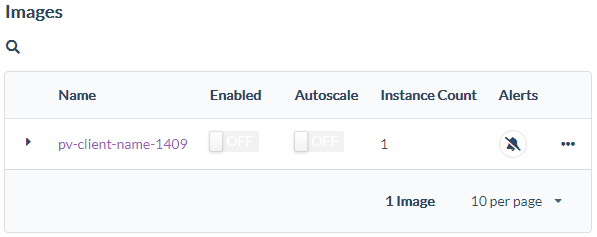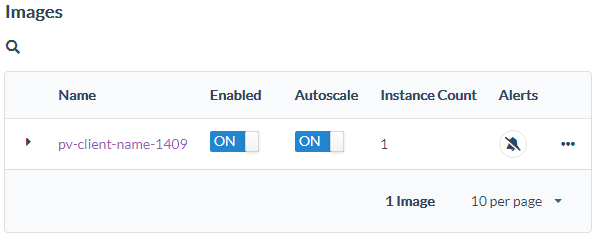Managing Images
Registered ProtectV images can be managed on the CipherTrust Manager console. Managing images includes viewing the list of registered images, viewing their details, and viewing the number of their running instances. Information such as whether the images are authorized for keys and whether their new clones will be granted keys automatically is also displayed.

Viewing Registered Images
To view registered images:
Log on to the CipherTrust Manager GUI.
Open the ProtectV application. The Images page is displayed on the right.

The Images page shows the list of registered images. The images are arranged in descending order of their registration time. The newly registered image is listed at the top. The page also shows the following details:
Item Description Name Name of the ProtectV Client image. Enabled Displays whether an image is authorized for key. If ON, then only partitions of instances based on this image will be encrypted. Autoscale Displays whether new clones of the image will be granted keys automatically. By default, autoscaling is turned OFF. New clones of the image will not be granted keys automatically. Instance Count Number of running instances of the image. By default, the instance count is 1. This means that the registered image itself is the first instance of the image. Alerts Alerts that the disk associated with the image will not be granted a key unless both the instance and the parent image are authorized/enabled. A red bell (  ) icon next to an image indicates an alert that requires a ProtectV administrator's attention.
) icon next to an image indicates an alert that requires a ProtectV administrator's attention.Expand Icon (  )
)Displays the Date Created field. This field shows the date and time of the image creation. The icon turns to the Collapse icon (  ). Click it to hide the date and time of image creation.
). Click it to hide the date and time of image creation.Overflow Icon (  )
)Displays additional information.
Unauthorizing an Image for Key
By default, an image is authorized for encryption keys. Encryption keys are available to them for decrypting data. However, if needed, you can unauthorize the image for encryption keys. It may be helpful in eliminating security risks arising from unauthorized cloning of images. For example, if you suspect that an image is cloned maliciously and stored data can be compromised, you can unauthorize such cloned images for encryption keys. The data stored on such clones remains encrypted/inaccessible until they are authorized for encryption keys.
To unauthorize an image for encryption keys:
Log on to the CipherTrust Manager GUI.
Open the ProtectV application. The Images page is displayed on the right. The following image shows that the image is authorized for encryption keys.

For the desired image, click the Enabled toggle switch to turn it OFF. This unauthorizes the image for encryption keys.

Authorizing an Image for Key
By default, an image is authorized for encryption keys. If its authorization is disabled, the ProtectV administrator can turn it on.
To authorize an image for encryption keys:
Log on to the CipherTrust Manager console.
Open the ProtectV application. The Images page is displayed on the right. The following image shows that the image is unauthorized for encryption keys.

For the desired image, click the Enabled toggle switch to turn it ON. This authorizes the image for encryption keys.

Enabling Autoscaling for an Image
By default, autoscaling of an image is turned off. Clones of the image (also known as image instances) are not granted encryption keys for decrypting data. However, if needed, autoscaling for an image can be enabled. When enabled, encryption keys will be granted to image instances automatically.
Note
Even if autoscaling for an image is turned off, its instances can be granted encryption keys individually. It can done by clicking the Authorized toggle switch on the Instances page.
To enable autoscaling of an image:
Log on to the CipherTrust Manager GUI.
Open the ProtectV application. The Images page is displayed on the right.

For the desired image, click the Autoscale toggle switch to turn it ON. This enables autoscaling of the image.

Disabling Autoscaling for an Image
By default, autoscaling of an image is turned off. If its autoscaling is enabled, the ProtectV administrator can disable it. When disabled, encryption keys will not be granted to image instances automatically.
To disable autoscaling of an image:
Log on to the CipherTrust Manager GUI.
Open the ProtectV application. The Images page is displayed on the right.

For the desired image, click the Autoscale toggle switch to turn it OFF. This disables autoscaling of the image.

Viewing Instances of an Image
To view instances based on an image:
Log on to the CipherTrust Manager GUI.
Open the ProtectV application. The Images page is displayed on the right.

Under Name, click a link to view running instances of the image.
Alternatively, click the overflow (
 ) icon corresponding to the desired image and click List Instances.
) icon corresponding to the desired image and click List Instances.
Note
If there are any instances based on an image, the overflow (
 ) icon is replaced by the List Instances button. The Delete option is available for images that have no instances based on them.
) icon is replaced by the List Instances button. The Delete option is available for images that have no instances based on them.The Instances page with details similar to the following is displayed.

This page lists the running instances of the selected image.

